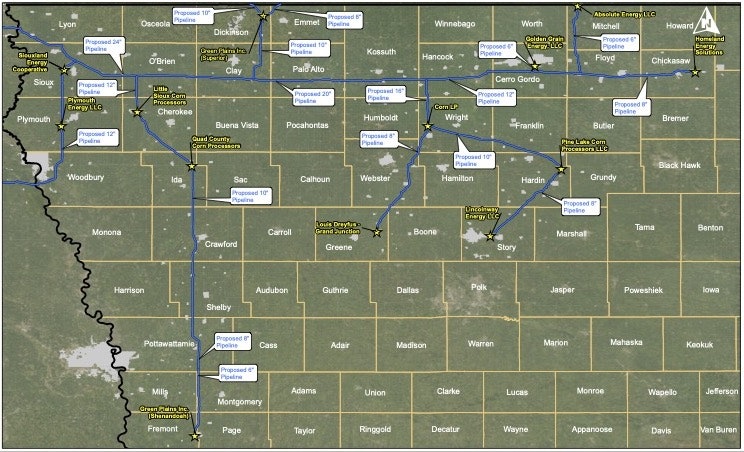
Summit Carbon Solutions proposed CO2 pipeline route in Iowa, from the company’s website
Bonnie Ewoldt is a Milford resident and Crawford County landowner.
As 2023 ended, CO2 pipelines were among the most newsworthy developments in Iowa. Summit Carbon Solutions’ proposed CO2 pipeline would cross more than 30 of Iowa’s 99 counties.
Heading into 2024, county boards of supervisors bear a heavy responsibility as they deal with ordinances while the state awaits the Iowa Utilities Board’s decision on Summit’s permit application.
Carbon capture and sequestration is not new. Oil companies have used CO2 pipelines for more than three decades to do Enhanced Oil Recovery, a process that renews reserves in abandoned oil wells. Most of the 5,300 miles of CO2 pipelines already built in the U.S. are used for enhanced oil recovery. They are located in uninhabited or low-population areas such as the oil-rich Bakken region of North Dakota, where people are not likely to be harmed by a break in the pipeline.
Summit Carbon Solution has often noted that there are currently 2.6 million miles of pipeline in the United States, making its plan sound like “just another pipeline.” The company overlooks the inconvenient detail that pipelines carry CO2 in a hazardous supercritical state across only 5,300 miles. Nothing on the scale of Summit’s massive 2,000-mile CO2 pipeline route through populated areas has ever been tried before.
CO2 under supercritical pressure is highly dangerous. If the pipeline breaks, the pressurized liquid CO2 converts from a fluid to gaseous state as it escapes. This creates an odorless, colorless plume that is heavier than air. It becomes an asphyxiant such that normal breathing cannot be sustained within 2,753 feet from the rupture of a pipeline 8 inches in diameter. Summit plans to use 24-inch pipes in several areas, increasing the impact of a rupture.
I was aware of the dangers of pressurized CO2 before I attended Summit’s first informational meeting for landowners in Spencer in October 2021. Imagine my surprise when I heard a Summit executive acknowledge there would be breaks in 2,000 miles of pipeline, then claim those would be inconsequential because the CO2 is just a “harmless gas that dissipates.”
Summit then launched a PR campaign peddling the CO2 as harmless—as safe as the “bubbles in your pop.” As landowners became more informed of the danger and less willing to sign easements, the company’s tone shifted. Summit began to acknowledge the risk, but claimed their carbon-steel pipes would not break.
Summit executives testified at the Iowa Utilities Board’s evidentiary hearing in Fort Dodge last fall. During the two years since that informational meeting in Spencer, the CO2 evolved from a harmless gas into a substance so dangerous that it was a national security risk.
Citing the possibility of a terrorism threat, Summit refused to share its plume study dispersion model at the hearing. Only under pressure from landowner and Sierra Club attorneys did the company agree to share its data, and then only in closed session. The public has yet to see Summit’s plume model. However, data from Navigator’s plume model for its now-defunct pipeline project is available for public examination.
Even though Summit knows its CO2 pipeline is extremely dangerous, it continues to demand narrow setbacks, with some as close as two hundred feet from homes. The company fiercely fights back against wider, safer setbacks in high-risk areas. Summit has sued four Iowa counties that have passed ordinances: Kossuth, Shelby, Story, and Emmet. Those cases either have yet to be decided or are on appeal.
In September, the federal government’s Pipeline and Hazardous Materials Safety Administration sent a letter to CO2 pipeline CEOs, informing them that the “… responsibility of siting new carbon dioxide pipelines rests largely with the individual states and counties….” Furthermore, the letter noted, “Local governments have traditionally exercised board powers to regulate land use, including setback distances and property development that includes development in the vicinity of pipelines.”
Local control is paramount in the face of Summit’s unbridled corporate power. Even with the looming threat of litigation, county boards of supervisors must exercise due diligence. They are duty-bound to protect their communities and keep citizens safe. Summit Carbon Solutions plays fast and loose with the facts.
County supervisors must do their own research on CO2 pipeline safety and pass updated CO2 pipeline ordinances as soon as possible. The Iowa Utilities Board’s decision on Summit’s permit is imminent.

1 Comment
local control plays well into divide and conquer
these companies are hard to regulate even with the full powers and resources of the federal and state governments in play without them this gets to be a very uneven fight. Hope someone who matters is listening to you folks.
dirkiniowacity Wed 10 Jan 6:17 PM